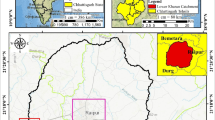Abstract
There have been multiple studies showing the comparison between land surface temperature—normalized difference built-up index (LST-NDBI) relationship especially in urban areas; however, many of the studies have lower accuracy while comparing LST-NDBI due to lower temporal availability of higher-resolution images particularly those used for LST derivation. The main reason behind this is the solid heterogeneity of land use-land cover (LULC) surfaces due to which LST changes drastically in space as well as in time; hence, it involves measurements with thorough spatial and temporal sampling. In this study, a comparison of the multi-temporal LST-NDBI relationship is done, and also, the further comparison is shown using LULC. The results are in agreement with previous studies which show a strong and positive correlation across the years (r = 0.69, r = 0.64 and r = 0.59 for 2001, 2011 and 2020, respectively). In addition, the LST trend shows the reduction in daytime LST over the years in the summer season which also reaffirms the findings of those very few studies conducted in semiarid regions. These results can help understand the effects of increasing built-up areas and the interclass LULC change on LSTs in urban settings. However, it is recommended that multi-seasonal comparisons will provide a better idea of the LST-NDBI relationship with higher-resolution LST maps.
Access this chapter
Tax calculation will be finalised at checkout
Purchases are for personal use only
Similar content being viewed by others
References
Hadeel AS, Jabbar MT, Chen X (2009) Application of remote sensing and GIS to the study of land use/cover change and urbanization expansion in Basrah province, Southern Iraq. Geo-Spatial Inf Sci 12(2):135–141
Chen YC, Chiu HW, Su YF, Wu YC, Cheng KS (2017) Does urbanization increase diurnal land surface temperature variation? Evidence and implications. Land Sc Urban Plan 157:247–258
Sultana S, Satyanarayana ANV (2018) Urban heat island intensity during winter over metropolitan cities of India using remote-sensing techniques: impact of urbanization. Int J Remote Sens 39(20):6692–6730
Madanian M, Soffianian AR, Soltani Koupai S, Pourmanafi S, Momeni M (2018) The study of thermal pattern changes using Landsat-derived land surface temperature in the central part of Isfahan province. Sustain Cities Soc 39(March):650–661
Macarof P, Statescu F (2017) Comparison of NDBI and NDVI as indicators of surface urban heat island effect in Landsat 8 Imagery: a case study of Iasi. Present Environ Sustain Dev 11(2):141–150
Naserikia M, Shamsabadi EA, Rafieian M, Filho WL (2019) The urban heat island in an urban context: A case study of Mashhad, Iran. Int J Environ Res Public Health 16(3)
Weng Q, Lu D, Schubring J (2004) Estimation of land surface temperature-vegetation abundance relationship for urban heat island studies. Remote Sens Environ 89(4):467–483
Malik MS, Shukla JP, Mishra S (2019) Relationship of LST, NDBI and NDVI using Landsat-8 data in Kandaihimmat watershed, Hoshangabad, India. Indian J Geo-Marine Sci 48(1):25–31
Abutaleb K, Ngie A, Darwish A, Ahmed M, Arafat S, Ahmed F (2015) Assessment of urban heat island using remotely sensed imagery over Greater Cairo, Egypt. Adv Remote Sens 04(01):35–47
Zha Y, Gao J, Ni S (2003) Use of normalized difference built-up index in automatically mapping urban areas from TM imagery. Int J Remote Sens 24(3):583–594
He C, Shi P, Xie D, Zhao Y (2010) Improving the normalized difference built-up index to map urban built-up areas using a semiautomatic segmentation approach. Remote Sens Lett 1(4):213–221
Liu L, Zhang Y (2011) Urban heat island analysis using the Landsat TM data and ASTER Data: A case study in Hong Kong. Remote Sens 3(7):1535–1552
Sun Q, Wu Z, Tan J (2012) The relationship between land surface temperature and land use/land cover in Guangzhou, China. Environ Earth Sci 65(6):1687–1694
Govil H, Guha S, Dey A, Gill N (2019) Seasonal evaluation of downscaled land surface temperature: a case study in a humid tropical city. Heliyon 5(6):e01923
Kumbhojkar S, Yosef R, Mehta A, Rakholia S (2020) A camera-trap home-range analysis of the Indian leopard (Panthera pardus fusca) in Jaipur, India. Animals 10(9):1–23
Guha S, Govil H, Gill N, Dey A (2020) A long-term seasonal analysis on the relationship between LST and NDBI using Landsat data. Quat Int (April)
Rongali G, Keshari AK, Gosain AK, Khosa R (2018) A mono-window algorithm for land surface temperature estimation from Landsat 8 thermal infrared sensor data: a case study of the Beas river basin, India. Pertanika J Sci Technol 26(2):829–840
Mathew A, Khandelwal S, Kaul N (2018) Spatio-temporal variations of surface temperatures of Ahmedabad city and its relationship with vegetation and urbanization parameters as indicators of surface temperatures. Remote Sens Appl Soc Environ 11:119–139
Rasul A, Balzter H, Smith C (2016) Diurnal and seasonal variation of surface urban cool and heat islands in the semi-arid city of Erbil, Iraq. Climate 4(3)
Mathew A, Khandelwal S, Kaul N (2017) Investigating spatial and seasonal variations of urban heat island effect over Jaipur city and its relationship with vegetation, urbanization and elevation parameters. Sustain Cities Soc 35:157–177
Author information
Authors and Affiliations
Editor information
Editors and Affiliations
Rights and permissions
Copyright information
© 2022 The Author(s), under exclusive license to Springer Nature Singapore Pte Ltd.
About this paper
Cite this paper
Chaudhary, A., Soni, C., Sharma, U., Joshi, N., Sharma, C. (2022). Multi-temporal Analysis of LST-NDBI Relationship with Respect to Land Use-Land Cover Change for Jaipur City, India. In: Saraswat, M., Sharma, H., Balachandran, K., Kim, J.H., Bansal, J.C. (eds) Congress on Intelligent Systems. Lecture Notes on Data Engineering and Communications Technologies, vol 111. Springer, Singapore. https://doi.org/10.1007/978-981-16-9113-3_23
Download citation
DOI: https://doi.org/10.1007/978-981-16-9113-3_23
Published:
Publisher Name: Springer, Singapore
Print ISBN: 978-981-16-9112-6
Online ISBN: 978-981-16-9113-3
eBook Packages: Intelligent Technologies and RoboticsIntelligent Technologies and Robotics (R0)




